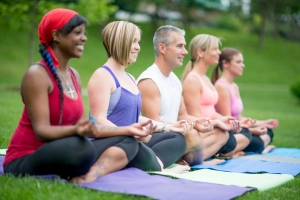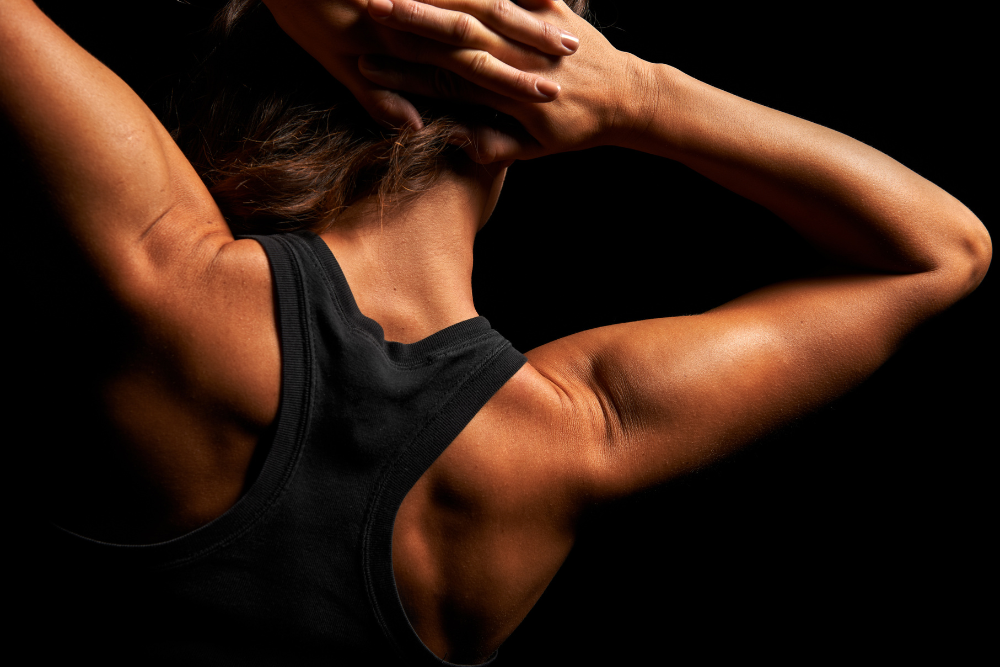SXS Health Challenge: A Long-Term Lifestyle Change

Gillian White – MSc, PhD Candidate, Department of Exercise Sciences, University of Toronto
Making lifestyle changes that stick
A conversation with the creators of the SXS health challenge
In a previous article, I detailed my experience of participating in a health challenge that included a combination of nutrition, exercise, and lifestyle changes.
In general, my thoughts on the challenge were generally positive, with my take being that the specificity of the restrictions and the scoring of points for good behaviour, as opposed to loss of points for bad behaviour, made it a pretty robust design. While I’ve detailed my perspective on the experience (and associated science) of participating in a health challenge, there is a method to the madness when these types of regimens as constructed.
To get the skinny on that, I went to the creators of the challenge that I took part in through SXS Fitness in Toronto, Stefan Overgaard and his wife Nadine Jackson-Overgaard.
Related Article: Health Challenges and Cleanses – A Help or Hinder?
The challenge in question includes:
No added sugar (>3g)
>6 servings of vegetables
>10 glasses of water
Workout (at or approved by SXS Fitness)
Weekly Nutrition Challenge (Weeks 1-4: no grains, no dairy, no alcohol, optional)
Daily Challenge (burpees, plank, yoga series, health article – increasing week to week)
Lifestyle (make your lunch, sleep 8h, meditation, massage, etc.)
About the Creators:
Stefan Overgaard – Trainer/owner proprietor, CanFitPro, CrossFit, Canadian Ski Coaching Federation Level 3, Canadian Ski Instructors Alliance Level 2.
Nadine Jackson-Overgaard – Naturopathic Doctor, Pilates, Spin, CrossFit, CanFitPro, Gymnastics Level 2
Can you tell us about the history of your challenge and how you’ve come to the current iteration?
This challenge has been ongoing and evolving over the last 10 years or so. The intention was to find different ways of making accountability easy and encompassing of all different aspects of health: lifestyle, nutrition, and fitness.
Basically, finding a simple and effective system that people can use to track, but more importantly, use to maintain lifestyle changes.
The scoring system takes into account everyday life –unforeseen obstacles to health behaviours or those we know about but take precedence over health challenges like parties etc. None of the principles are new – they’ve been made mainstream by groups like Weight Watchers and apps that use online tracking.
The slight advantage with this one is that it’s not so cumbersome that you can’t stick to it, but also no so oversimplified that important information is lost so that you can kind of cut corners.
We do it a couple of times a year in our community and can tweak the challenge to alter the focus (i.e. “liver” challenge or youth focused). It’s been trial and error to get to this version – when it’s too restrictive (i.e. grain, dairy, or alcohol all cut at once), only a fraction of the people who start stick with it for the full 4 weeks, which is counter to the intention of the challenge which is to promote sustainable behavioural changes.
What is the rationale behind the categories that you’ve selected?
No added sugar
 This one is pretty obvious. There are so many health risks associated with refined sugar – chronic disease and inflammation (which basically covers every illness – diabetes, heart disease, cancer etc.). The only habits worse than a high sugar diet are smoking and sitting all day. When you put them together it’s a disaster. Even for healthy people who don’t eat a ton of added sugar, when you’re forced to look at food labels of products that you might take for granted n your diet, you’d be surprised to find where sugar hides (salad dressing, sauces..).
This one is pretty obvious. There are so many health risks associated with refined sugar – chronic disease and inflammation (which basically covers every illness – diabetes, heart disease, cancer etc.). The only habits worse than a high sugar diet are smoking and sitting all day. When you put them together it’s a disaster. Even for healthy people who don’t eat a ton of added sugar, when you’re forced to look at food labels of products that you might take for granted n your diet, you’d be surprised to find where sugar hides (salad dressing, sauces..).
We don’t include fruit since those sugars aren’t refined and allow for post-workout sugar, like you might find in a protein shake, since those will be taken in by the muscle to replenish stores you used during your workout.
Related Article: Sugar – Is It Hurting Your Healthy Lifestyle?
6 Vegetables
 The bottom line for this one is micronutrients. You can’t beat vegetables or nutrient density (amount of vitamins/minerals for amount of calories in a food). People just don’t eat enough vegetables so setting the 6-serving limit is actually pretty challenging for most people.
The bottom line for this one is micronutrients. You can’t beat vegetables or nutrient density (amount of vitamins/minerals for amount of calories in a food). People just don’t eat enough vegetables so setting the 6-serving limit is actually pretty challenging for most people.
It forces you to include them in snacks and all meals so not only do you benefit from the nutrient density of vegetables, which basically can’t be beat, but you’re also displacing other less nutrient dense snack options that might be part of your diet.
This is also one that you can kind of make up for lapses in other areas because life happens – maybe you had something sugary at a party – you still have the flexibility to get points for doing the right thing in other areas like getting your 6 servings of veg.
It’s about sustainability so you need to have a system with some flexibility. Something super restrictive like Biggest Loser or Dr. Bernstein diets – they work in the short term but in the vast majority of cases aren’t going to last. You need to make a little bit of room for failure to be successful overall.
10 glasses of water
 Again, people just don’t drink enough water. We’re too quick to grab a coffee or other beverage before water. When you set the 10 glass minimum, people start to realize that they’re actually really thirsty. As well you displace beverages that are maybe not providing anything healthy, like just or cocktails.
Again, people just don’t drink enough water. We’re too quick to grab a coffee or other beverage before water. When you set the 10 glass minimum, people start to realize that they’re actually really thirsty. As well you displace beverages that are maybe not providing anything healthy, like just or cocktails.
Workouts (4-5/week)
 Within our challenge, we’re specific about the workouts that you score being high-intensity. In other words, they need to push your body hard enough to provide an adaptation stimulus. So while recovery jogs are great, they aren’t going on the score board. With that said, we do encourage people to limit themselves to 4-5 workouts per week to avoid overtraining.
Within our challenge, we’re specific about the workouts that you score being high-intensity. In other words, they need to push your body hard enough to provide an adaptation stimulus. So while recovery jogs are great, they aren’t going on the score board. With that said, we do encourage people to limit themselves to 4-5 workouts per week to avoid overtraining.
It’s a limitation of the App that we use because you can score up to 7 workouts each week, even though we discourage it. We used to have prizes but we’ve cut them in the last few years because some people would put the challenge ahead of their health, which takes away from the fundamental purpose of the challenge which is to make positive behaviour modifications that are sustainable.
Self-care/Lifestyle habits
 These are basically small changes that people often don’t appreciate the health benefits of, especially the sleep component. Sleep is such a big one and it’s something that people are largely lacking and/or are much less familiar with so it’s often taken for granted. Sure, some people can get away with 5h but they don’t realize how much better they would feel and how much more productive they will be if they get more sleep.
These are basically small changes that people often don’t appreciate the health benefits of, especially the sleep component. Sleep is such a big one and it’s something that people are largely lacking and/or are much less familiar with so it’s often taken for granted. Sure, some people can get away with 5h but they don’t realize how much better they would feel and how much more productive they will be if they get more sleep.
It’s a health habit that’s really overlooked, probably because it’s a passive health behaviour. Other options in this category (making your lunch, meditating, getting a massage) are there to support the holistic side of the challenge. Overall, these all aim to reduce stress, which isn’t really tangible but generally when you’re pushed to do them, you just feel better.
Related Article: 7 Tips To Get You Sleeping Again
What’s the rationale behind the scoring system?
The scoring system allows us to put more weight on different behaviour changes. So the most points are associated with the nutrition challenge (grain, dairy, alcohol on their respective weeks) and workouts, with the others being associated with moderate point values. This is because the nutrition element is only for a week so we really want people committing to those changes and the workout component is just always important (and we operate a gym..so..).
What’s your ultimate goal for the people who participate?
This goes back to what we should have lead with which is that this is about behaviour modification. It’s a simple tool to help modify behaviour. So hopefully when the 4 weeks is up, people have made some changes that they can sustain.
It’s giving people the tools to make these changes in a simple and effective manner. So, everyone knows that eating better, exercising more etc. is “good for you” but these things are abstract – how do we do that in a practical way that is consistent with how we live?
We think this challenge gives people the tools they need to do that as well as a taste of what it’s like when you commit to these changes.
Any other comments for our readers?
A good but sustainable system is better in the long-term than a perfect but unsustainable system. We know this isn’t perfect but it is effective.
You Might Like:














